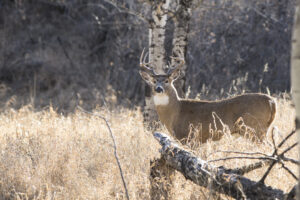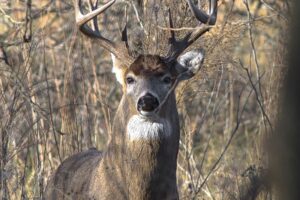
Chronic Wasting Disease (CWD) is a degenerative and contagious neurological disorder that affects deer, elk, and moose populations. It is caused by a misfolded prion protein and leads to progressive wasting, behavioral changes, and eventually death in infected animals. With no cure available, CWD has the potential to have significant impacts on wildlife populations, as well as raise concerns about potential risks to human health. In this article, we will explore what CWD is, its symptoms and impacts, the potential risks to humans, and what preventative measures can be taken to minimize its spread.
What is Chronic Wasting Disease?
CWD is a contagious neurological disorder caused by a misfolded prion protein. Prions are normally found in the body and play a role in maintaining the structure of cells. However, in the case of CWD, the prions are misfolded and cause brain damage, leading to the progressive wasting and death of infected animals. CWD is highly contagious and can persist in the environment for years, making it difficult to control and contain.
The disease was first discovered in captive mule deer in Colorado in the late 1960s, but it is believed to have been present in wild populations for many years prior to that. Since then, CWD has spread to more than 24 states in the US and several Canadian provinces, as well as to South Korea and Norway.
Symptoms and Impacts of CWD
The symptoms of CWD typically appear slowly over time, with infected animals showing signs of weight loss, behavioral changes, and difficulty walking. Eventually, they may become emaciated, weak, and unable to stand or move, leading to death. There is also evidence to suggest that CWD can affect the reproductive ability of infected animals, which can have a significant impact on population numbers over time.
The impacts of CWD on wildlife populations can be substantial. With no cure available, infected animals will die, leading to a decline in population numbers. Additionally, the disease can spread rapidly through populations, making it difficult to control and contain. The loss of wildlife can also have significant economic impacts, as hunting and tourism are important sources of revenue for many communities.
Risks to Humans
While CWD does not affect humans directly, there is some evidence to suggest that it may pose a risk to human health. The Centers for Disease Control and Prevention (CDC) and the World Health Organization (WHO) have both stated that there is no evidence that CWD can be transmitted to humans, but the long incubation period and the lack of any definitive studies make it difficult to say for certain. As a precaution, the CDC and the WHO both recommend that people avoid eating meat from infected animals, and that hunters take appropriate measures to minimize the risk of exposure.

Preventative Measures
There is currently no cure for CWD, and the best way to manage the disease is through preventative measures. This includes controlling the movement of animals, such as by limiting the importation of live animals, and avoiding feeding or baiting deer and elk, which can concentrate animals in a single area and increase the spread of the disease. In areas where CWD is already present, hunting can be used as a tool for managing populations, but it is important to take appropriate precautions to minimize the risk of spreading the disease.
Conclusion
In conclusion, Chronic Wasting Disease is a growing concern among wildlife biologists and hunters. It is a degenerative and contagious neurological disorder that affects deer, elk, and moose populations and is caused by a misfolded prion protein. The disease is highly contagious, has no cure and has the potential to have significant impacts on wildlife populations and pose a risk to human health. While the risk to human health is currently unknown, it is recommended to avoid exposure to infected animals and their bodily fluids. The best way to manage the spread of CWD is through preventative measures such as limiting the movement of animals, avoiding feeding or baiting of deer and elk, and using hunting as a tool for managing populations while taking appropriate precautions. It is important to continue monitoring and researching the disease in order to better understand its impacts and develop effective management strategies.





Leave a Reply
Your email is safe with us.